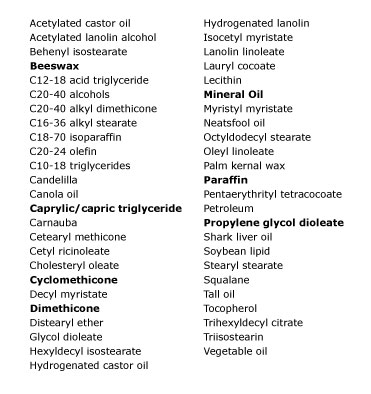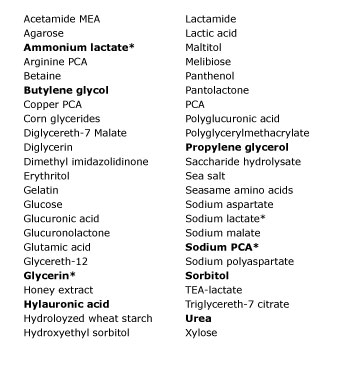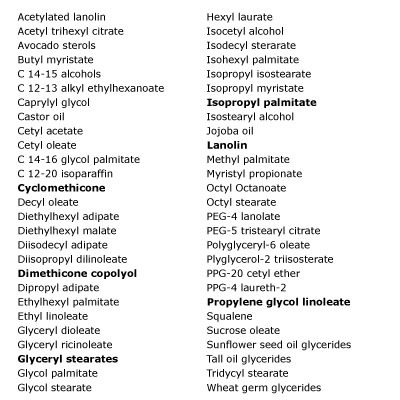Moisturizer Ingredients In Skin Care Products
- Oil based Emollients
- lanolin and other animal oils,
- mineral oil (petrochemical oil) — occlusive
- petrolatum (Vaseline)
- plant oils (botanical oils)
- Castor oil
- Shea butter
- and more….
- saturated fatty acids and salts or ester of saturated fatty acids
- Stearic Acid (18:0)
- sastearates
- myristates
- palmitates
- Other lipids
- Squalane
- triglycerides
- phospholipids
- lecithin
- ceramides
- Water based Emollients
- acetyl alcohol
- silicone and silicone-derived ingredients
- silicone
- dimethicone
- cyclomethicone
- Dimethicone Copolyol
- Water binding agent (Humectant)
- hyaluronic acid
- urea
- glycerin and glyceryl ester
- glycerin
- glycereth-26
- propylene glycol
- sodium PCA
- sorbitol (a sugar alcohol)
- glucose, fructose, sucrose and sugar derivatives
- polysaccharide (natural moisturizing factors)
- beta-glucan
- glycosaminoglycans
- glycogen
- amino acids
- cholesterol
- lipid (phospholipids) molecular components
- inositol
- choline
- Amphipathic Emollient
- fatty alcohols
- Cetyl Alcohol (palmityl alcohol)
- Cetearyl Alcohol (Cetostearyl alcohol)
- Ceteareth–20 (polyethylene glycol ether of Cetearyl Alcohol )
- fatty alcohols
- Moisturizing Botanical Extracts
Dehydration (dryness) is a common sign associated with aging skin. Dehydration can cause skin to sag, loss of elasticity which in turn, with destruction of connective tissue fiber protein collagen and elastin, results in wrinkles. Therefore, moisturizing or emollient (substances that soften and soothe the skin) agents or ingredients are essential components of an anti-aging skin care cream. Or, moisturizing creams is an integral part of an anti-aging skin care regimen or kits.
Moisturizers don’t just make dry skin feel nicer. Moisturizers not only increase the skin’s water content, but they also protect the skin and encourage an orderly desquamation (shedding) process that makes the skin appear more smooth. They provide a temporary support system to fill in for lost collagen and elastin, as well as help to repair the skin’s own moisture retention capacity. Also, keeping the skin plumped with moisture slows the progression and deepening of wrinkles.
Emollients are substances that soften and soothe the skin. They are used to correct dryness and scaling of the skin to make skin soft, supple, smooth and plump. Emollients have three basic properties: 1. Occlusion – providing a layer of oil on the surface of the skin to slow water loss through evaporation and thus increase the moisture content of the stratum corneum (figure 1). 2. Humectant – increasing the water-holding capacity of the stratum corneum (figure 2). 3. Lubrication – adding slip or glide across the skin.(figure 3) When choosing a moisturizer for your dry skin, look for one that contains both emollients and water binding agents (humectant). One ingredient can have 1 or more of above properties. (e.g. lanolin is occlusive and lubricating). The terms in bold are the most commonly used and the starred ingredients are the most effective.
figure 1. Occlusion Ingredients

figure 2. Humectant Ingredients

figure3. Lubrication Ingredients

Humectants (Water binding agents) attract water from the dermis into the epidermis, increasing the water content in the epidermis. When humidity is higher than 70 percent, humectants can also attract water from the atmosphere into the epidermis. Humectants are also useful in softening thickened or scaly skin. Water binding agents are ingredients that not only bind water to the outer layer of dry skin, but also work to repair the external skin matrix.
Occlusives (those emollients that have occlusive property) increase the water content of the skin by slowing the evaporation of water from the surface of the skin. These ingredients are often greasy (oil-based emollients) and are most effective when applied to damp skin. Mineral oil is often used because of its favorable texture, but it is not as effective at preventing evaporation of water as many other occlusives. Lanolin is expensive and potentially irritating. Silicone derivatives (dimethicone and cyclomethicone) are not greasy but have a limited moisturizing effect.
Lubricating Emollients help maintain the soft, smooth, and pliable appearance of the skin. Lubricating Emollients are often thought of as “filling in the crevices” between corneocytes that are in the process of desquamation (shedding). The type of emollient used in a moisturizer plays a key role in its “skin slip,” which is the smooth feeling imparted to the skin after application.
One of the primary elements in keeping skin healthy is making sure the structure of the epidermis (outer layer of skin) is intact. The components that do this are often called natural moisturizing factor (NMF). NMFs do this by loosening dry, hardened cells to expose their water binding sites thereby enabling the skin to retain water as nature intended. They are so-named because they are part of the epidermis structure which function as skin’s natural or internal moisturizing (emollient) system. All of the skin’s supporting NMFs and lipids are present in the intercellular structure of the epidermis, both between skin cells and in the lipid content on skin cell membrane.
NMFs make up an expansive group of ingredients that include amino acids, lipids (e.g. ceramides and lecithin), hyaluronic acid, cholesterol, fatty acids, triglycerides, phospholipids, glycosphingolipids, urea, linoleic acid, glycosaminoglycans, glycerin, mucopolysaccharide, and sodium PCA (pyrrolidone carboxylic acid).
Emollients are either oil based, which means that a small amount of water is dissolved in oil, or water based, which means they are primarily water and have a light, nongreasy feel. Oil-based creams leave a slight residue on the skin and have more staying power than water-based creams do. Lanolin, mineral oil, petrolatum, and other ingredients fill in the spaces between the cells in the skin, helping replace lipids and thus smoothing and lubricating rough skin. Water-based creams are easier to apply and don’t leave much of a residue, but they don’t have as much staying power. Most creams and lotions on the market are water based.
Which moisturizer is best
The moisturizer that’s best for you depends on many factors, including your skin type, your age and whether you have specific conditions, such as acne. For general guidelines, consider the following:
• Normal skin. Normal skin is neither too dry nor too oily. To maintain this natural moisture balance, use a water-based moisturizer that has a light, nongreasy feel. These moisturizers often contain lightweight oils, such as acetyl alcohol, or silicone-derived ingredients, such as cyclomethicone.
• Dry skin. To restore moisture to dry skin, choose a heavier, oil-based moisturizer that contains urea or propylene glycol — chemicals that help keep your skin moist. For very dry, cracked skin, oils are preferable. They have more staying power than creams do and are more effective at preventing water from evaporating from your skin.
• Oily skin. Oily skin is prone to acne and breakouts. Though oily, such skin still needs moisture, especially after using skin-care products that remove oils and dry out the skin. In addition, a light moisturizer can help protect your skin after washing. Be sure to pick a water-based product that is labeled “noncomedogenic,” which means it won’t clog pores.
• Sensitive skin. Sensitive skin is susceptible to skin irritations, redness, itching or rashes. Use a moisturizer that doesn’t contain potential allergens, such as fragrances or dyes, and is specifically designed for sensitive skin.
• Mature skin. As you age, your skin tends to become drier because your oil-producing glands become less active. To keep your skin soft and well hydrated, choose an oil-based moisturizer that contains petrolatum as the base, along with lactic acid or alpha hydroxy acids (AHA). These exfoliating ingredients also help hold in moisture and prevent flaky, scaly skin.
Subpages